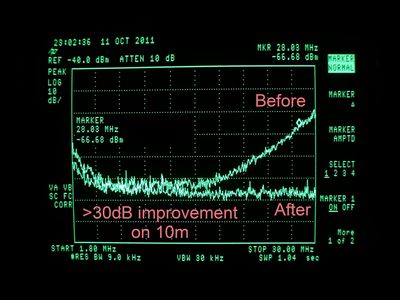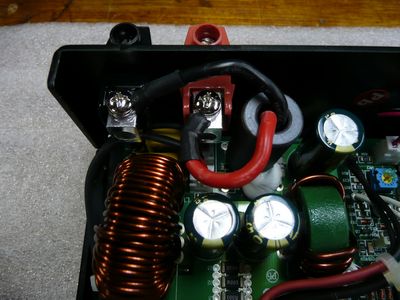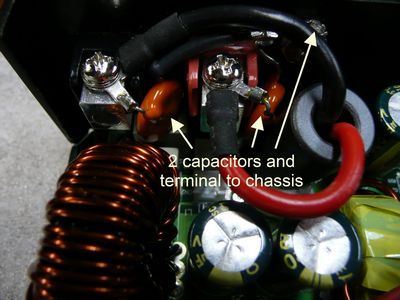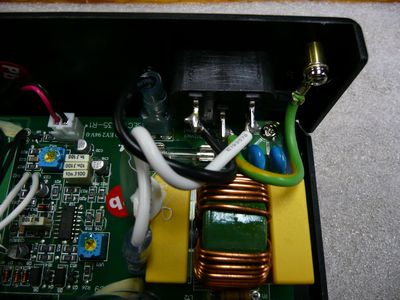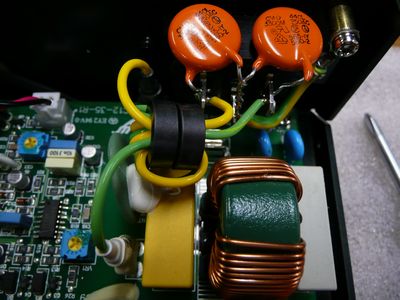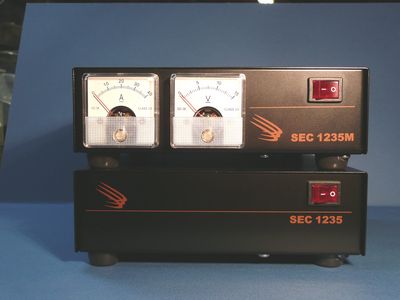Surprise RF Interference
Samlex SEC 1235/1235M 12VDC Power Supplies
Page content last updated Nov. 10, 2011
Copyright © 2011 Larry Benko, W0QE
I purchased a Samlex SEC 1235 (12VDC 35A) power supply about 3 years ago. Subsequent common mode current measurements on both the AC and DC leads showed very low currents in the HF region and on the air measurements showed no RF interference. I purchased two more SEC 1235M supplies a few years later which are the same as the SEC 1235 except for the addition of the voltage and current meters. All 3 supplies have been reliable, good performers, and very RF quiet.
The two pictures below show several RF filtering chokes and capacitors within the supply as delivered from the manufacturer.
The two pictures below show several RF filtering chokes and capacitors within the supply as delivered from the manufacturer.
Click on any picture for a larger image.
Recently I was doing some bench tests and had one of the SEC 1235 supplies powering a small short wave receiver I was using. I noticed some interference at about an S4 level on 10m (28 MHz) with the whip antenna on the receiver and thought it was due to the circuit I was working on. However it turned out to be coming from the SEC 1235 supply. A second SEC 1235 was tried and it also produced the noise so the chances of both supplies having the same problem was extremely low. Upon further examination both SEC 1235 supplies ONLY generated RF noise when the DC load was less than approximately 1A. My original tests were done with a load current of about 15A and the small short wave receiver drew less than 100mA.
I used an industry standard 50uH LISN (Line Impedance Stabilization Network) on the AC side of the SEC 1235 to measure the RF noise on the AC line. The "Before" curve on the graph on the right shows the noise from the SEC 1235 with no DC load. The rise in noise from about 15MHz to above 30MHz was not present if the DC current draw was 1A which explained why I had never heard over the air RF noise. Click on the graph for a larger image.
Typical solutions such as common mode chokes on #43 or #31 material cores having common mode impedances in the range of 2k ohms did reduce the interference but did not eliminate it. A small radio with only a whip antenna uses the power supply leads (if not being run on batteries) as part of the antenna so any common mode current on the DC input couples very well into the radio. Yikes! No wonder why the common mode chokes were only marginally successful.
Typical solutions such as common mode chokes on #43 or #31 material cores having common mode impedances in the range of 2k ohms did reduce the interference but did not eliminate it. A small radio with only a whip antenna uses the power supply leads (if not being run on batteries) as part of the antenna so any common mode current on the DC input couples very well into the radio. Yikes! No wonder why the common mode chokes were only marginally successful.
A common mode choke works in a simple manner to limit the common mode (antenna) current on a wire(s) based on the common mode source impedance AND the common mode load impedance. The common mode impedances are NOT the same as the differential impedances that we are more familiar with. A given common mode choke is much more effective if the common mode source and load impedances are low. As an exercise I decided to see if I could totally eliminte the RF interference without doing too much to the SEC 1235 supply.
The final solution was to add one additional common mode choke on the Line and Neutral AC wires (not on the safety ground) and to add 4 capacitors which were 3300pF UL rated 250VAC. The DC ouput already had a single turn common mode choke as can be seen in the picture below and to the right. By drilling a small hole in the back panel and connecting a capacitor on each DC lead to the case the "effective" common mode impedance seen by the single turn choke was greatly reduced and the effectiveness of the choke was increased. Likewise it was a little hard to figure out the AC input filtering so I just added a small common mode choke with 4 turns on the Line and Neutral wire thru two FT50-43 cores. Then 2 more 3300pF capacitors (need 250VAC rated ones here) were soldered directly to the IEC connector from Line/Neutral and safety ground which is also the case as shown in the picture below and to the left. These capacitors also appear to lower the common mode impedance on the AC side of the supply.
The resulting LISN measurements can be seen in the "After" line in graph above with a better than 30dB improvement at 28MHz. Additionally no noise was heard in the short wave receiver when the SEC 1235 was connected to the short wave receiver only. In total 4 different SEC 1235(M) supplies were measured and subsequently modified with all showing the same results.
The final solution was to add one additional common mode choke on the Line and Neutral AC wires (not on the safety ground) and to add 4 capacitors which were 3300pF UL rated 250VAC. The DC ouput already had a single turn common mode choke as can be seen in the picture below and to the right. By drilling a small hole in the back panel and connecting a capacitor on each DC lead to the case the "effective" common mode impedance seen by the single turn choke was greatly reduced and the effectiveness of the choke was increased. Likewise it was a little hard to figure out the AC input filtering so I just added a small common mode choke with 4 turns on the Line and Neutral wire thru two FT50-43 cores. Then 2 more 3300pF capacitors (need 250VAC rated ones here) were soldered directly to the IEC connector from Line/Neutral and safety ground which is also the case as shown in the picture below and to the left. These capacitors also appear to lower the common mode impedance on the AC side of the supply.
The resulting LISN measurements can be seen in the "After" line in graph above with a better than 30dB improvement at 28MHz. Additionally no noise was heard in the short wave receiver when the SEC 1235 was connected to the short wave receiver only. In total 4 different SEC 1235(M) supplies were measured and subsequently modified with all showing the same results.
SEC 1235 power supply showing modifications to the AC input and DC output (Click on picture for larger image).

